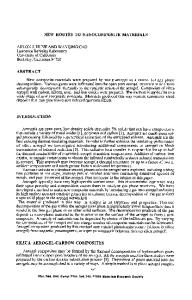The Promise of Nanocomposite Thermoelectric Materials
- PDF / 1,041,841 Bytes
- 13 Pages / 612 x 792 pts (letter) Page_size
- 113 Downloads / 409 Views
1166-N02-01
The Promise of Nanocomposite Thermoelectric Materials M.S. Dresselhaus1, G. Chen1, Z.F. Ren2, K. McEnaney1, G. Dresselhaus1, and J.-P. Fleurial3 1 Massachusetts Institute of Technology, 77 Massachusetts Ave., Cambridge, MA 02139 U.S.A. 2 Boston College, 140 Commonwealth Ave., Chestnut Hill, MA 02467 USA 3 Jet Propulsion Laboratory, 4800 Oak Grove Dr., Pasadena, CA 91109 USA ABSTRACT The concept of using nanocomposite thermoelectric materials in bulk form for practical applications is presented. Laboratory studies have shown the possibilities of nanostructures to yield large reductions in the thermal conductivity while at the same time increasing the power factor. Theoretical studies have suggested that structural ordering in nano-systems is not necessary for the enhancement of ZT, leading to the idea of using nanocomposites as a practical scale-up technology for making bulk thermoelectric materials with enhanced ZT values. Specific examples are presented of nanocomposite thermoelectric materials developed by our group based on the familiar silicon germanium system, showing enhanced thermoelectric performance through nano-structuring. INTRODUCTION: THE ENERGY CHALLENGE Thermo-electricity in the larger energy picture During the 21st century inhabitants on our planet expect to be making a transition from today's fossil fuel based economy to an energy economy that will be sustainable over the long term. The drivers for this transition to a sustainable energy scenario include the increase in global population, going from today's 6.5 billion people to 8.9 billion (see figure 1(a)) by 2050. The last 30 years have not only witnessed an increasing energy demand per person, but people worldwide have aspired to a higher standard of living, resulting in a super-linear increase in energy demand over this time period (see figure 1(b)). Despite the large efforts in increasing energy efficiency and to some degree energy conservation, the increasing energy demands, especially from the developing world (see figure 1(b)), have in large part contributed to the super-linear aspect of the increasing energy demand worldwide. Extrapolating into the future, the energy demands are expected to double from today's 15±2 TW level to about the 30 TW level by mid-century. To address this huge increase in energy demand over a short time period of 40 years is a daunting challenge to our global population, not only from an energy standpoint, but also from an environmental standpoint as over the last thousand years there has been a notable increase in global both mean temperature (by ~1°C) and CO2 levels (to about 380 PPM).
Figure 1. Historical and projected global population1,2 and energy demand3.
Figure 2. Ice core data5 for temperature and atmospheric CO2 and CH4. When looking at data from ice core records that go back in history, we see that natural events on our planet (occurring over a period of ~400,000 years) result in fluctuations in the temperature of about 10°C over 100,000 year periods, so that the man-made effect of a 1°C
Data Loading...











